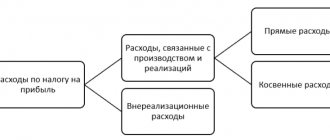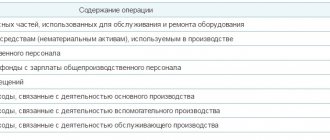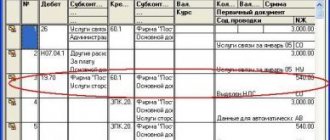Off-balance sheet account meaning
Keeping records of inventory items that have been accepted for storage until they become the property of the enterprise should be carried out using off-balance sheet position 002. If we consider off-balance sheet accounts in general, the essence of their purpose is to reflect the category of goods, according to which the organization does not have ownership rights, i.e. they are received for use for a certain period of time. In this case, we can talk not only about the designated products, but also about conditional rights and obligations.
Balance sheet position 002 is active, and therefore, when products are received, their amount is reflected on the debit side, and relocation or disposal on the credit side. In this case, the cost of incoming working capital should be reflected in accordance with the documents attached at the time of delivery. If it is not indicated, then the assessment should be conditional or reflected in quantitative terms.
Lesson 9.10
Lesson 9
Disposal of fixed assets.
In accordance with PBU 6/01, the cost of an item of fixed assets that is retired or is not capable of bringing economic benefits (income) to the organization in the future is subject to write-off from accounting.
In particular, the reason for the disposal of fixed assets may be:
- Sale;
- Termination of use due to moral or physical wear and tear;
- Liquidation in case of an accident, natural disaster and other emergency situation;
- Transfer in the form of a contribution to the authorized capital of another organization;
- Transfer in the form of a contribution to a mutual fund;
- Transfer under an agreement of exchange, gift;
- Making a contribution under a joint venture agreement;
- Identification of shortages or damage to assets during their inventory;
- Partial liquidation during reconstruction work.
Accounting (in accordance with PBU 6/01) and tax accounting (in accordance with Chapter 25 of the Tax Code of the Russian Federation) provide for various rules for recognizing income and expenses arising from the disposal of fixed assets.
Thus, in accounting, if a fixed asset is written off as a result of its sale, then the proceeds from the sale are accepted for accounting in the amount agreed upon by the parties to the agreement. Income and expenses from writing off fixed assets from accounting are reflected in accounting in the reporting period to which they relate. Income and expenses from writing off fixed assets from accounting are subject to credit to the profit and loss account as other income and expenses.
The general scheme of entries in accounting accounts when writing off fixed assets is as follows: first, the initial cost of the object and the amount of accumulated depreciation are written off to account 01.09 “Retirement of fixed assets”, after which, depending on the type of transaction, the residual value of the object is attributed either to account 91 “ Other income and expenses" (during the sale, transfer of fixed assets), or to account 99 "Profits and losses" (in case of natural disasters). If an object for which 100% depreciation has been accrued is written off and dismantled, you can take into account the materials remaining from the object (D10 K91) as other income, and the dismantling costs as other expenses (K91 D60, 70, etc. )
To process transactions for the disposal of fixed assets in 1C: Accounting, several documents are provided: Preparation for the transfer of fixed assets, Transfer of fixed assets, Write-off of fixed assets.
Preparing for OS transfer
Preparing for OS transfer (OS > Preparing for OS transfer) . The document is used when a transaction for the transfer of fixed assets is subject to state registration, when this transaction lasts for quite a long time, for example, the deregistration of an object is carried out in one reporting period, and the transfer in another. That is, it turns out that the object may not be used by the organization, but be listed on its balance sheet.
Suppose we want to prepare for transfer in connection with the sale of an Air Conditioner (inventory number 000000002), the operation takes place on 02/25/2009.
In the figure below you can see the form of the document Preparation for OS transfer .
The details of the document header are filled in using quite standard methods, but the tabular part of Fixed Assets requires some clarification. This tabular part is filled out based on information on the OS object of interest to us, stored in the system. In order for the system to automatically fill out this tabular part, using the Selection , select the OS that we want to prepare for transfer. Next, you need to execute the command Fill> For OS list . Let's look at what data the table was filled with.
- Cost (AC) - this field contains the initial cost of the fixed asset according to accounting data. In our case - 54,300 rubles.
- Ost. cost (BU) - residual value of the object - 28,055 rubles.
- Depreciation (wear and tear) (BU) - the amount of accumulated depreciation according to accounting data - 25,340 rubles.
- Shock absorption per month (wear) (BU) — this field contains the amount of depreciation that should be additionally accrued for the object for the current month. The system calculated the amount of depreciation for additional accrual as 905 rubles. This is the monthly depreciation amount. For a retired object, the full amount of depreciation is charged for the last month of its use. This feature of depreciation calculation is reflected in PBU 6/01:
The accrual of depreciation charges for an object of fixed assets ceases from the first day of the month following the month of full repayment of the cost of this object or the write-off of this object from accounting.
The fields related to tax accounting, in our case, are filled in similarly to the corresponding fields in accounting, however, this will not be the case for all OS objects.
Let's run through the document and see what movements it generated:
The document generated the following accounting entries:
| D20.01 K02.01 905 rub. Depreciation has been calculated for the last month of use of the fixed asset. |
| D02.01 K01.09 26245 rub. The amount of accrued depreciation is written off. |
| D01.09 K01.01 54,300 rub. The book value (initial) value of the asset has been written off. |
Similar entries were made in tax accounting.
In the information registers Accrual of depreciation of fixed assets (accounting) and Accrual of depreciation of fixed assets (tax accounting) an entry was made that depreciation for this fixed asset no longer needs to be calculated.
In the information register of Organization OS Events, a record was made about the event Preparation for transfer for the Air Conditioner .
OS transfer
OS Transfer document ( OS > OS Transfer ) performs the following actions:
- Adds additional depreciation on the written-off fixed assets;
- Writes off the OS from accounting;
- Makes records of settlements with counterparties for the transferred fixed assets.
Above we looked at the document Preparing for OS transfer . In fact, the document Transfer of fixed assets can replace the document Preparation for transfer of fixed assets ; it is used when transactions for the disposal of fixed assets occur in one reporting period (month).
The documents Transfer of OS and Preparation for transfer of OS can be used together.
Let's consider an example of transferring an OS object Air Conditioner , which we prepared for transfer in the previous section:
03/02/2009 the air conditioner is out of service. It is purchased from our organization “Developer” LLC. The implementation takes place within the framework of Agreement No. 1 dated 03/02/2009, our organization issued invoice No. 45 dated 03/02/2009, the air conditioner was sold for 35,000 rubles, incl. VAT 5338.98 rub.
Let's create the OS Transfer document :
Let's consider filling out the details of the document header:
| Organization: | The organization for which records are kept, in our case, is “Furniture Maker”; |
| Counterparty: | The organization to which the OS is transferred; |
| Event: | Event with the event type “Transfer” (directory Events with fixed assets); |
| Subdivision: | The division of the organization from which the operating system is being removed, in our case - the Production Shop; |
| Agreement: | Agreement on the basis of which the asset is transferred; |
| Document preparation: | a document of the type Preparation for transfer of OS in the event that preparation for transfer was carried out using a similar document. If the document Transfer of Assets is drawn up for a fixed asset that was not prepared for transfer before the document was issued, the document independently generates all the necessary records. |
In the tabular section, the Basic means of recording are made automatically - based on the data from the document for preparing the OS for transfer. You need to manually fill in the Amount - indicating in this field the amount for which the fixed asset was sold, and %VAT , indicating the VAT percentage rate.
Let's post the document (using the OK ), then open the document form and enter information about the invoice.
Let's see what movements the document generated:
In accounting, the document generated transactions of the following type:
| D62.01 K91.01 35,000 rub. — Revenue from the sale of fixed assets is reflected; |
| D91.02 K68.02 5338.98 rub. — VAT payable to the budget has been allocated; |
| D91.02 K01.09 28055 rub. — The residual value of the sold fixed asset is reflected. |
Revenue from sales was reflected (as other income), and VAT on sales and the residual value of the written-off air conditioner were reflected as an expense.
The following entries were made in tax accounting:
| DPV K91.01.1 29661.02 - Reflects the amount of revenue from the sale of an asset; |
| D91.02.1 K01.09 28055 - The residual value of the written-off fixed asset is reflected; |
account “Receipt and disposal of property, work, services, rights” is used in tax accounting to record transactions corresponding to its name.
Decommissioning of OS
The document Write-off of fixed assets ( OS > Write-off of fixed assets ) is used to write off fixed assets that are morally or physically obsolete or are subject to liquidation due to an emergency.
Consider this example:
The Epson printer used by the administration has become unusable and must be deregistered.
Let's execute the command OS > Write-off of fixed assets , when filling out the document we will do the same as we did when filling out the document Disposal of fixed assets .
In the Event we enter the Write-off (event type Write-off ) from the directory Events with fixed assets .
In the Account (BU) and Account (NU) we made entries about accounts 91.02 and 91.02.1, respectively. In accordance with the specifics of disposal of fixed assets, there may be other accounts here. Accordingly, in the Subconto (BU) and Subconto (NU) , you should select the appropriate subcontos, in our case these are Income (expenses) associated with the liquidation of fixed assets .
In the Reason , enter the reason for disposal of the fixed assets, selecting it from the appropriate directory.
The tabular part of Fixed Assets is filled out in two steps. First, add a new OS object (that is, fill in the fields Fixed Asset and Inv. No. ) with the Add (or the Selection ). Next, using the command Fill > For list of fixed assets , the system fills the remaining fields of the tabular row with data on the residual value of fixed assets, accrued depreciation and depreciation for the current month, which needs to be additionally charged.
When generating this document, you can print form No. OS-4 - this form is used to generate an act on the write-off of an asset.
Let's review the document and see what entries it has generated in accounting:
The document generated the following accounting entries:
| D26 K02.01 - for the amount of additional depreciation; |
| D02.01 K01.09 - accrued depreciation is written off; |
| D01.09 K01.01 - the initial cost of the fixed asset is written off; |
| D91.02 K01.09 - the residual value of the fixed asset is written off. |
Types of current assets accounted for off-balance sheet
In this case, enterprises and organizations reflect those goods that for some reason are unable to be reflected on the corresponding balance sheet accounts:
- this may be a situation where the received product turns out to be defective, damaged or does not meet the agreed parameters specified in the terms of the contract, and therefore must be returned to the seller;
- if the ownership of the purchased products passes after the purchase price is paid, and not at the time of delivery;
- if the specified values are taken into account under the pledge agreement;
- if the specified category of goods has already been paid for by the enterprise, but the supplier for some reason did not have time to transport the order from the warehouse;
- when goods and materials are received under an exchange agreement, by mistake.
Definition of fixed assets
Fixed assets of an enterprise are the material assets of an enterprise used in economic activities and transferring their value to the cost of production.
Fixed assets
The OS includes:
- production equipment and machinery;
- buildings and constructions;
- roads;
- transmission networks (heating networks, electrical networks, etc.);
- means of transport;
- power machines and equipment;
- various equipment and tools;
- working and breeding livestock;
- other OS.
In addition, fixed assets include capital investments in leased fixed assets, in land improvement, and the land plots themselves. Fixed assets, as non-current assets, participate in the production process as a means, not an object.
Conditions for recognizing an object as a fixed asset
To recognize an OS object, the following conditions must be present simultaneously:
- purpose - use in the production activities of the organization;
- expected SPI over 12 months;
- promising economic benefits;
- not intended for resale.
OS costing less than 40,000 rubles. can be taken into account as part of inventories and immediately written off as costs.
The fixed assets accounting account is active, its structure is displayed in the form of a table:
In the standard version, synthetic account 01 includes subaccounts for breakdown by type of fixed assets.
To reflect disposals, a sub-account for the disposal of fixed assets is also often opened, into which the initial and written-off costs are collected, and the write-off is carried out from this account. If the disposal account is not used, then transactions Dt 02 - Kt 01 arise.
For the correctness of analytical accounting, a breakdown is carried out by objects. Items in the account are stated at their original cost, which may include shipping costs, fees, etc.
If an asset is owned by several organizations, then in the accounting of each of them its value is reflected in proportion to the share of ownership.
Main correspondence of account 01
Typical correspondence of the fixed assets accounting account is presented in the table:
Modernization of fixed assets is the transformation of the operating system, which led to an improvement in its characteristics.
An increase in the cost of fixed assets due to the modernization or reconstruction of an object is reflected by standard posting:
| Dt | CT | Operation description |
| 01 | 08 | Cost increase amount |
Increase in value after revaluation:
| Dt | CT | Operation description |
| 01 | 83 | Revaluation amount |
Depreciation of fixed assets
Depreciation of fixed assets in accounting refers to the gradual transfer of their value to the cost of manufactured products.
There are categories of property that are not subject to depreciation:
- land;
- environmental management facilities;
- livestock;
- non-production housing facilities;
- forestry, road management;
- external landscaping.
If repairs last more than one year, and conservation of objects lasts more than three months, then depreciation is suspended.
In the balance sheet, fixed assets are reflected at their residual value: original cost minus accumulated depreciation. Non-depreciable property is reflected in the balance sheet at historical cost.
Depreciation starts from the month following the commissioning date. The accrual will stop in the next month after the cost has been completely written off.
After the book value of the asset becomes zero, the asset is not reflected in the balance sheet.
Typical entries for balance sheet item 002
As for standard accounting records for the movement of inventory items, here we can highlight:
- Dt 002 and Kt of the corresponding position - receipt of valuables for storage;
- Dt ... and Kt 002 - write-off of inventory items due to their return to the supplier;
- Dt 002 and Kt... - products received with special conditions for the transfer of ownership;
- Dt ... and Kt 002 - write-off of valuables that were accepted under special conditions;
- Dt 002 and Kt ... - accepted goods and materials due to failure to fulfill obligations under the pledge agreement;
- Dt... and Kt 002 – sale of values accepted under the pledge agreement.
Reflection of off-balance sheet transactions with the supplier
Accounting for the designated category of goods under item 002 in the case of a supplier is carried out in a situation where the ownership of them has already transferred to the buyer.
Thus, the seller reflects these values deposited in 41 accounts. Once they are returned to the warehouse and remain the property of the supplier. In this case, account 002 will not be used for accounting records.
Thus, the receipt of goods for storage, as well as their return, is reflected in the following transactions:
Dt 002
Kt 002
Accounting for off-balance sheet transactions with the buyer (postings, examples)
In practice, there are cases when the buyer does not have the right to capitalize designated categories of goods as part of maintaining accounting records. This can happen when the delivered products turn out to be of poor quality, defective or in insufficient quantities.
Account characteristics
The accrued amount of depreciation is reflected within the accounting system for loan 02 in correspondence with the accounts associated with the accounting of production costs. An organization acting as a lessor reflects the accrued amount of depreciation on fixed assets leased under Dt 91 Kt 02, if other income is generated through rent.
In the event of disposal of fixed assets (during the sale, write-off, liquidation process, gratuitous transfer), the amount of accrued depreciation is subject to write-off in Kt 01. A similar entry is made if the amount of accrued depreciation for missing or used fixed assets is written off.







